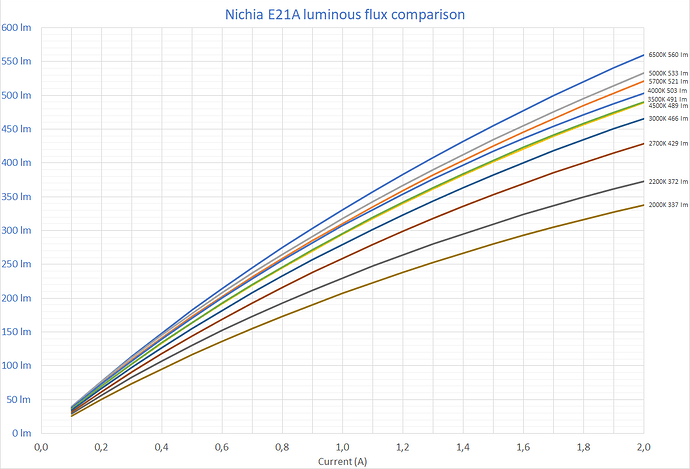Which would be more efficient at 1000lm this or an XHP70.2 on a single cell set up?
The Cree, by far. They are very different types of LEDs though. The 70.x is about 4 times as large as a 519A, has a way larger light emitting surface and way lower light quality. Also, different supply voltages. They need different reflectors/TIRs (or, at least, gaskets) and drivers.
What exactly is your plan?
Hi I am building a bicycle light. to run off of a single 21700 with an E switch driver. I am looking for something that can run between 500-1500 comfortably. Would the 70.2 not be wasted due to its capability?
If your main goal is efficiency at ~1000lm, and light quality is of lower importance, I would probably opt for a Luminus SFT-70 R70, or Cree XHP50.3 HI R70. Each paired with a 6V 1.5A boost driver. Should be ~1200lm on the SFT-70 6500K, and probably similar on a similarly cool white 50.3 HI. Another good contender is a Cree XM-L3 with a 3A buck driver.
7070 class emitters are a bit more efficient, but in return make finding matching optics that are not huge a pain.
LED size aside how efficient would the XHP70.2 be with a boost? I want a niceclean floody beam with out rings.
i think the community would benefit from a graph like this but for all 519a ccts and possibly dedomed and you seem like the man to do it
I don’t know if this will be worth the effort–these tests are very resource-intensive and a privilege to have. It is common knowledge that lower CCTs tend to have lower measured lumens due to the shape of the luminosity function, and people who choose lower CCTs with this in mind–the difference is really not significant if they know what they want. There’s a good chance you can simply estimate the output of a lower CCT by taking the measurements for a higher CCT, and normalizing by an appropriate ratio of spectral efficacies.
This is pointless, it’s not just about what QReciprocity42 has already said, but also in the fact that this requires sampling of each color temperature, since the existing spread between LEDs in the datasheet is very significant, in addition, in the course of production, technologies often change, as well as performance.
Well, but where would you get these if not from measurements? I am also fairly certain it’s not only a multiplicative offset, but probably something nonlinear due to the different phosphor mixtures reaching saturation at different pumping powers. Probably different between high and low CRI LEDs and between different companies or even LED models, too.
It would be very interesting to see such a test but imo it’s not feasible. I know roughly how much effort a single one of the tests koef3 does is, and doing 10 or so for a single LED is not something I would be ready to do in my free time if I were him, so I wouldn’t ask it of him either ![]()
With a fully automated test setup this could be done, but with a semi-manual setup it’s an incredible effort.
Well said.
Yeah. XHP70.3 R70 has the same set of flux bins for every CCT from 6500K to 4000K. And only at 3500K flux starts to lower (interesting that 7000K also has lower bins). Maybe probability of having higher bin differs for different CCTs, though.
Also Simon’s store offers XHP70.2 4000K with higher flux bin than 6500K version has.
True, but these factors do not prevent one from obtaining useful estimates up to sample variance. In the plot of E21A from before, we observe luminous efficacy increasing from 2000K to 3000K, and beyond that the emitters are no longer ordered by CCT and thus the differences are likely insignificant up to sample variance.
While imperfect, Planckian spectra truncated to 5% sensitivity is a usable approximation to the spectra of high CRI LEDs of comparable CCT. Figure 3 (p4) of this paper plots the spectral efficacy of such truncated sources as a function of CCT, which exhibits the same general trends as the E21A plots: significant increase from 2000K to 3000K, and leveling off after.
Of course, this is no longer applicable for low CRI sources, which are poorly approximable by even truncated Planckian spectra.
To exemplify what normalization I mean: assume that you know the output of a 5000K emitter, and that a 3000K emitter has the same radiometric power (probably lower in reality but this gives a useful upper bound). Then the output of the 3000K is estimable by (5000K output)x(3000K spectral efficacy)/(5000K spectral efficacy), which equals (5000K radiometric power)x(5000K spectral efficacy)x(3000K spectral efficacy)/(5000K spectral efficacy), which upon cancellation equals (5000K radiometric power)x(3000K spectral efficacy)=(3000K output) due to equal power assumption. These efficacy values can be estimated from the paper above.
That’s an interesting phenomenon, and I wonder if someone has tested the emitters to confirm the binning. I am not sure how much to trust the binning info–I’ve had a U6 and V2 bin sample of the old XPL HI where the U6 visibly outperforms the higher V2-binned emitter on a 2.8A 7135 driver.
